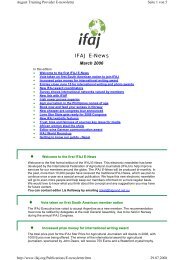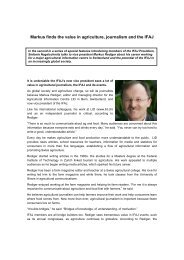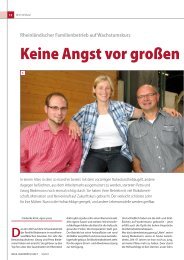Sweden! - International Federation of Agricultural Journalists
Sweden! - International Federation of Agricultural Journalists
Sweden! - International Federation of Agricultural Journalists
Create successful ePaper yourself
Turn your PDF publications into a flip-book with our unique Google optimized e-Paper software.
24 SOLUTIONS FOR A GREEN FUTURE<br />
Cattle<br />
Problems<br />
Beef cattle herds are to a great extent, still<br />
quite small. Farmers who work with beef<br />
cattle tend to be older as cattle production<br />
has <strong>of</strong>ten been seen as a way for a dairy<br />
farmer to wind down their workload prior<br />
to retirement. Another problem is the abolition<br />
<strong>of</strong> EU subsidies for bulls and steers,<br />
which disappears at the turn <strong>of</strong> 2011–2012.<br />
The EU subsidy has been a source <strong>of</strong> income<br />
for many beef producers and the risk<br />
is that they will not regard it worthwhile<br />
to continue production when the subsidy<br />
is withdrawn. There is also the risk that a<br />
large number <strong>of</strong> animals will be slaughtered<br />
at the end <strong>of</strong> 2011 so that the farmers<br />
will get as much subsidy as possible. If this<br />
happens there is a more than possible risk<br />
that Swedish beef production will diminish<br />
greatly in the years that follow.<br />
Fewer beef producers<br />
The number <strong>of</strong> farms rearing cattle for<br />
meat production has decreased over the<br />
last few years. After the peak in the mid-<br />
1990s, the number <strong>of</strong> farms with animals<br />
reared for beef is now back to the same level<br />
as it was at the beginning <strong>of</strong> the 1980s.<br />
Small herds<br />
The average herd <strong>of</strong> cattle reared for beef<br />
production consisted <strong>of</strong> 16 animals in 2009<br />
compared to 6 animals in 1980.<br />
Where are the herds?<br />
Geographically, most cattle are found in<br />
Skåne and Västra Götaland. Combined,<br />
these two counties have nearly a third <strong>of</strong><br />
<strong>Sweden</strong>’s cattle.<br />
Breeds<br />
Charolais and Hereford are among the<br />
predominant breeds <strong>of</strong> cattle in <strong>Sweden</strong>.<br />
Prices <strong>of</strong> beef<br />
During 2010, the abattoirs’ basic listing<br />
prices varied between 23–26 SEK per<br />
kilogram. The price <strong>of</strong> cows has been approximately<br />
5 SEK less. In addition to the<br />
basic listing price, the slaughter companies<br />
pay extra for frequent and full deliveries.<br />
A farmer who delivers at least 15 cattle per<br />
week gets about 1 SEK extra per kilogram.<br />
If fewer animals are delivered, the added<br />
extra payment is lowered.<br />
Import and export<br />
<strong>Sweden</strong>’s imports <strong>of</strong> beef dropped by 8.8<br />
percent in 2009 but rose by 8.4 percent in<br />
2010. 50 percent <strong>of</strong> Swedish consumption<br />
<strong>of</strong> beef is imported meat.<br />
Ireland is incomparably the largest exporter<br />
<strong>of</strong> beef to <strong>Sweden</strong>, supplying nearly<br />
one third <strong>of</strong> all beef imports. Germany is<br />
second and Denmark third.<br />
Slaughter<br />
Approximately 425,000 cattle were slaughtered<br />
in 2010. This is 65,000 less than in<br />
2000. Sixteen abattoirs spread out over<br />
the country accounted for 94 percent <strong>of</strong><br />
<strong>Sweden</strong>’s slaughter <strong>of</strong> animals in 2010. l










